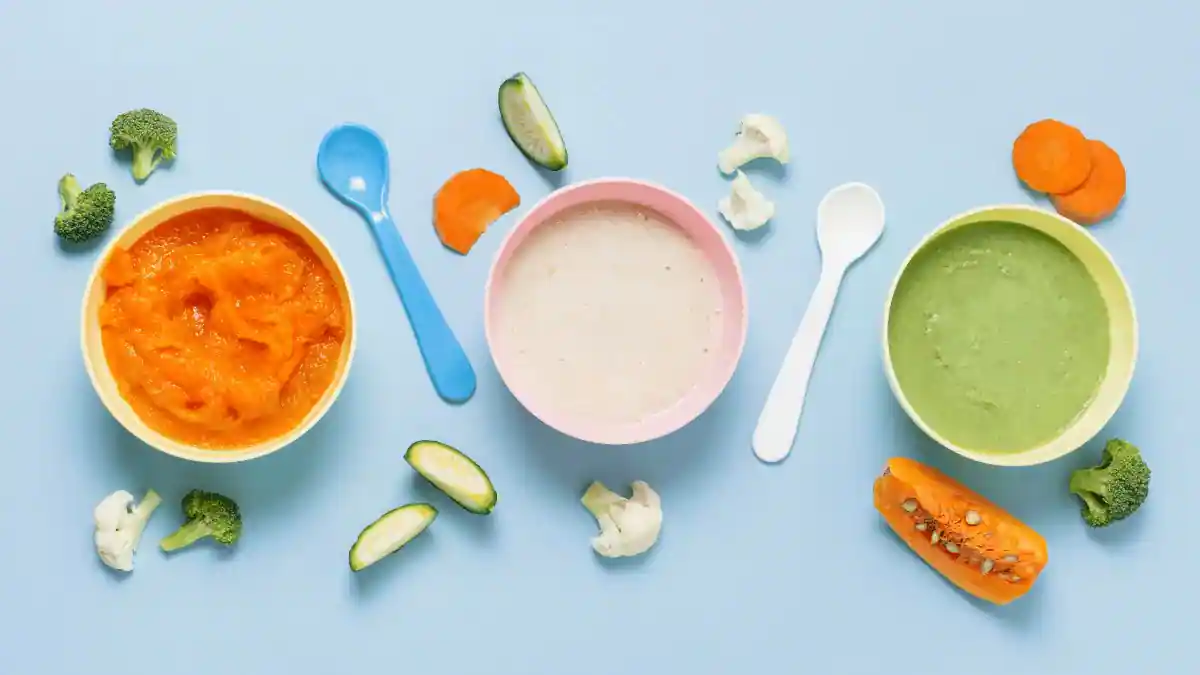Share This Article
Homemade baby food and recipes are an excellent way to provide your infant with fresh, nutritious, customized meals. In this article, we will explore the benefits of making baby food at home. We will also look at essential tips for getting started, and some easy-to-follow recipes to kickstart your culinary journey for your little one.
Preparing homemade baby food is a beautiful way to ensure your child receives nutritious and wholesome meals during their crucial developmental years. By making baby food at home, parents have control over the ingredients, allowing them to avoid preservatives, added sugars, and excess salt found in store-bought options. This hands-on approach also enables parents to introduce various flavours and textures, catering to their baby’s preferences and nutritional needs. In this article, we will explore the benefits of homemade baby food. It will also provide tips for preparation and storage, and share a selection of simple and delicious recipes to support your baby’s growth and development.
1. The Advantages of Homemade Baby Food
a. Nutritional Value
Homemade baby food allows you to control the ingredients, ensuring your baby receives optimal nutrition, vitamins, and essential nutrients.
b. No Additives or Preservatives

Preparing baby food at home eliminates the need for additives or preservatives commonly found in store-bought alternatives, offering a purer and healthier option.
2. Getting Started with Homemade Baby Food
a. Appropriate Age
Introduce solids when your baby is developmentally ready, typically around six months of age, as advised by doctors.
b. Basics of Baby Nutrition

Familiarize yourself with the basics of infant nutrition, including introducing single-ingredient foods and the gradual progression to mixed flavours and textures.
3. Equipment and Preparation
a. Essential Tools
Gather the necessary equipment, such as a food processor or blender, steamer, and storage containers for baby food.
b. Sanitization

Ensure all utensils and containers are thoroughly sanitized to maintain food safety for your baby.
4. Homemade Baby Food Ingredients
a. Fresh Fruits and Vegetables
Fresh, seasonal fruits and vegetables are the foundation of homemade baby food. Opt for organic options when possible.
b. Proteins

Introduce protein sources like poultry, fish, and legumes. Ensure that meat is thoroughly cooked and pureed for easy digestion.
5. Homemade Baby Food Cooking Methods
a. Steaming
Steaming is a gentle cooking method that retains nutrients. It is ideal for vegetables and fruits, which can then be pureed.
b. Baking

Baking is a method for preparing sweet potatoes, squash, and fruits like apples, resulting in a soft texture suitable for pureeing.
6. Recipe Ideas: First Foods
a. Single-Ingredient Purees
Start with single-ingredient purees like mashed bananas, avocado, or cooked and pureed sweet potatoes. These options are easy on your baby’s sensitive digestive system.
b. Rice Cereal

Homemade rice cereal is a nutritious and easy-to-make option. Blend rice into a fine powder and cook with water to create a smooth and digestible consistency.
7. Recipe Ideas: Exploring Flavors
a. Vegetable Medley
Create a vegetable medley by steaming and pureeing a combination of carrots, peas, and green beans. This introduces your baby to diverse flavours.
b. Fruit Compotes

Prepare fruit compotes by stewing apples or pears with a hint of cinnamon or nutmeg. These provide a delightful taste variation.
8. Recipe Ideas: Texture and Variety
a. Mashed Potatoes
As your baby grows, introduce mashed potatoes. Mash boiled potatoes and add a small amount of breast milk or formula for a creamy texture.
b. Oatmeal

Homemade oatmeal is an excellent source of fibre. Cook rolled oats with water, breast milk, or formula and offer it as a more textured meal.
9. Combining Ingredients
a. Introducing Proteins
Begin introducing proteins like chicken or lentils by blending them into vegetable purees. This combination offers a balanced meal.
b. Finger Foods

Transition to finger foods when your baby shows signs of readiness. Soft, bite-sized pieces of cooked vegetables or fruits make for excellent options.
10. Maintaining Nutritional Balance
a. Balancing Nutrients
Keep a balanced diet in mind by offering a variety of foods. Aim to include a mix of fruits, vegetables, proteins, and grains.
b. Iron-Rich Foods

Include iron-rich foods like lean meats, fortified cereals, and legumes to support your baby’s growth and development.
11. Baby Food Storage and Safety
a. Proper Storage
Store homemade baby food in airtight containers in the refrigerator for a short duration. Consider freezing in ice cube trays for long-term storage.
b. Avoiding Allergens

Be cautious with allergenic foods like peanuts and shellfish. Introduce these gradually and observe for any adverse reactions.
12. Monitoring Allergies and Reactions
a. Signs of Allergies
Be aware of signs of food allergies, including hives, rashes, vomiting, or diarrhoea. If you suspect an allergy, consult a paediatrician.
b. Slow Introduction

Introduce new foods one at a time, waiting a few days before introducing another. This helps identify potential allergens.
13. Transitioning to Solid Foods
a. Baby-Led Weaning
Consider baby-led weaning as an approach to transitioning to solid foods. It allows your baby to explore foods at their own pace.
b. Support Independence

Encourage self-feeding as your baby grows. Provide small, soft pieces of food to support motor skill development.
14. Homemade Baby Food and Convenience
a. Batch Cooking
Save time by batch cooking and freezing portions for future meals. This is especially helpful for busy parents.
b. Convenience with Nutrition

Homemade baby food offers the convenience of store-bought options while providing superior nutrition and flavour.
Homemade baby food and recipes empower parents to provide fresh, nutritious, customized meals that cater to their baby’s growth and development. With the right tools, information, and a willingness to explore, you can create a culinary journey that nourishes your baby’s body and sense of taste. As your little one grows, introducing various foods and textures will help them develop a well-rounded palate and a lifelong love for healthy eating.

